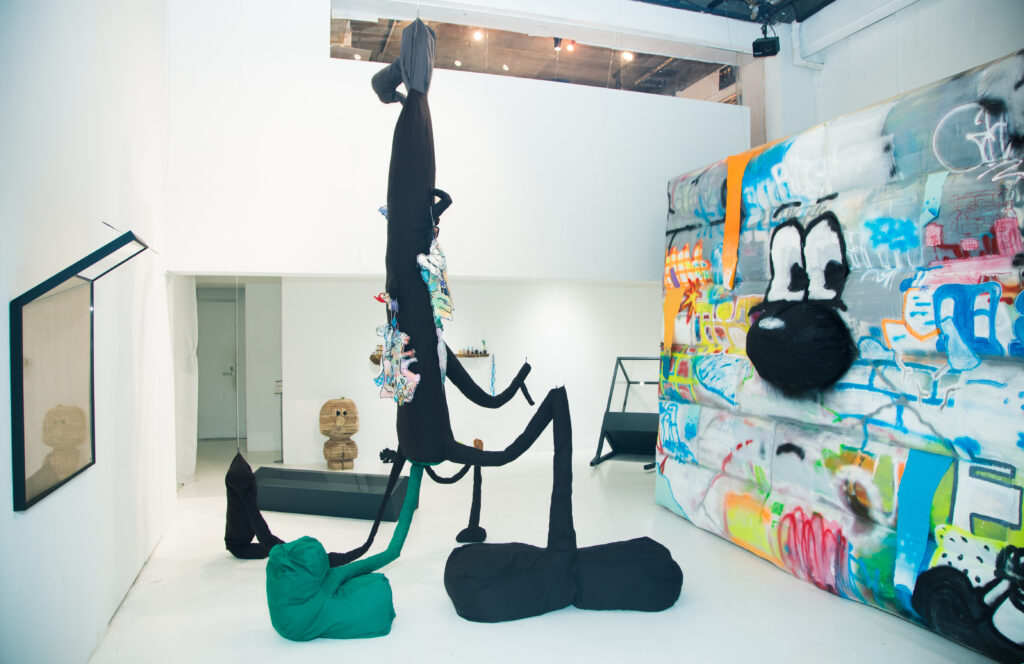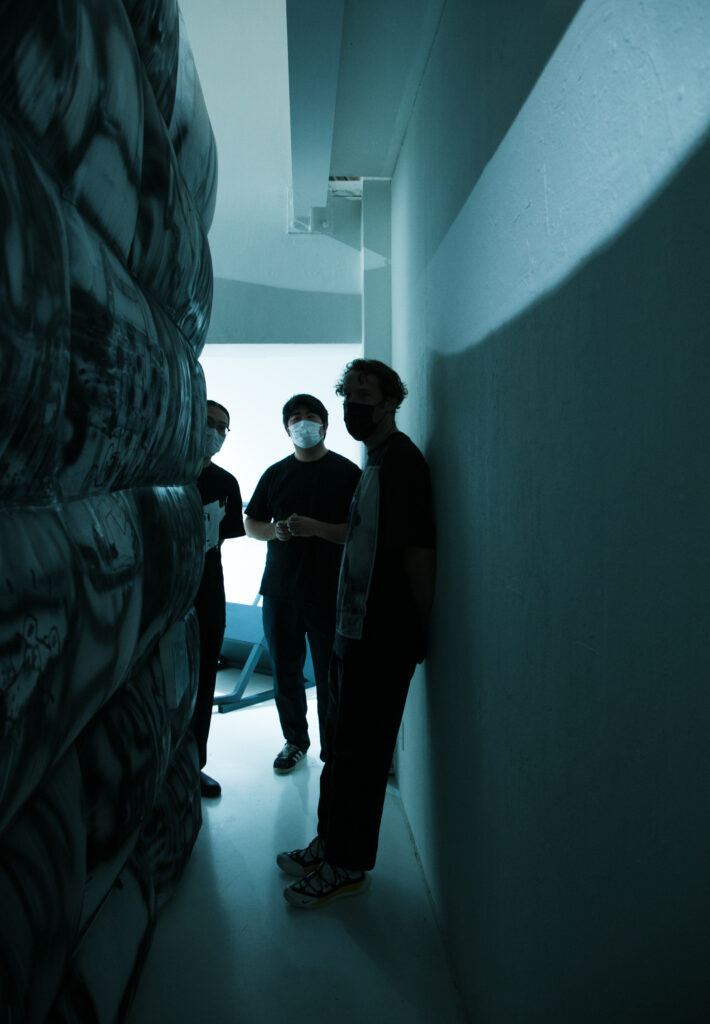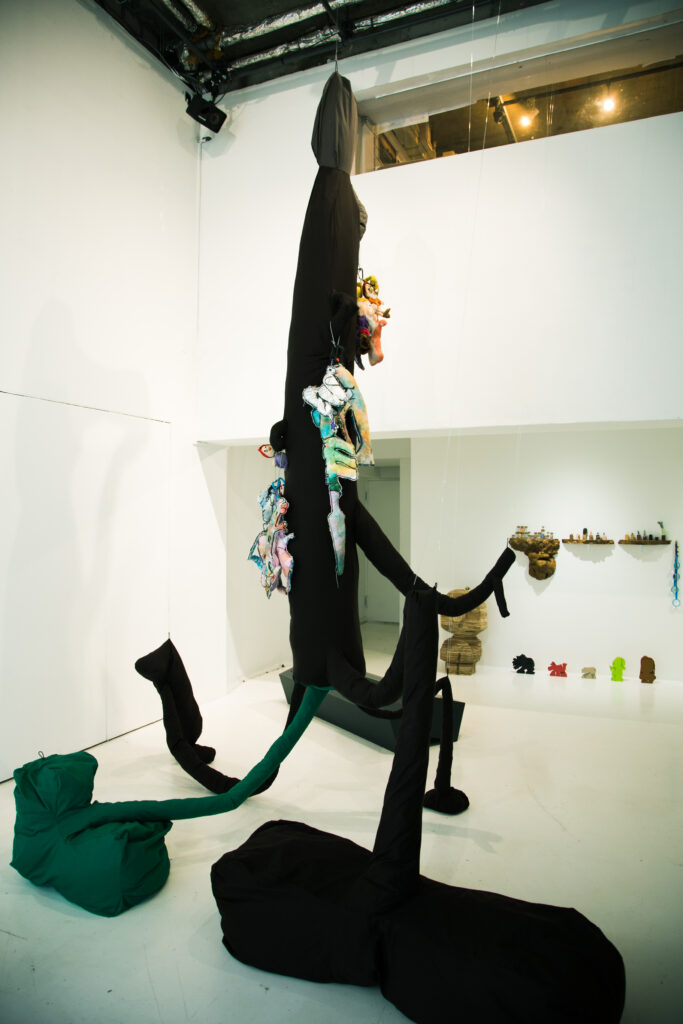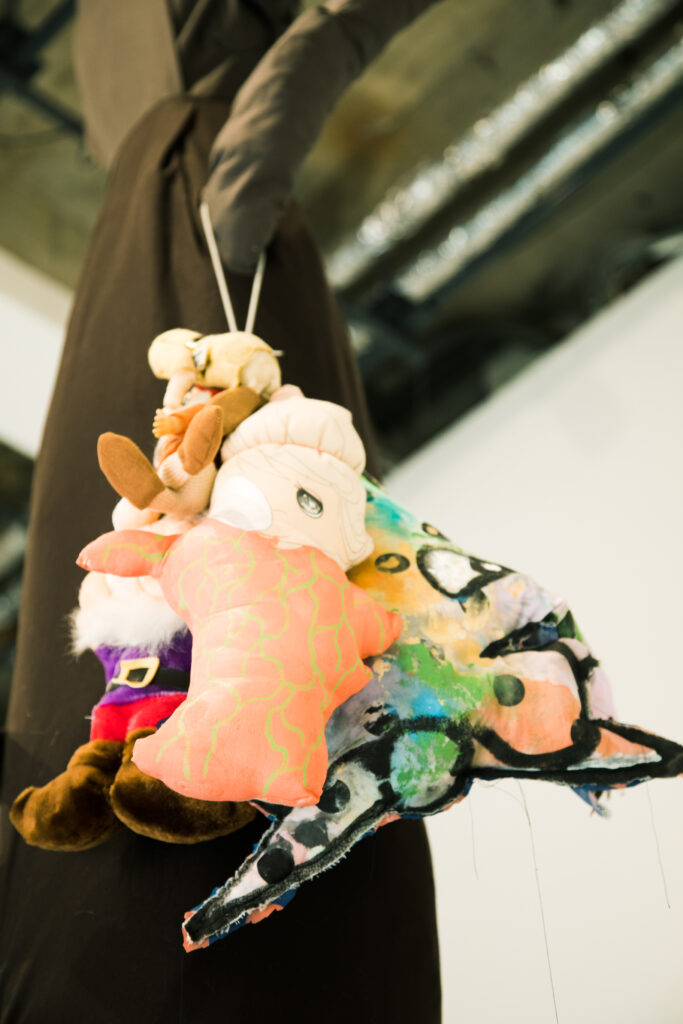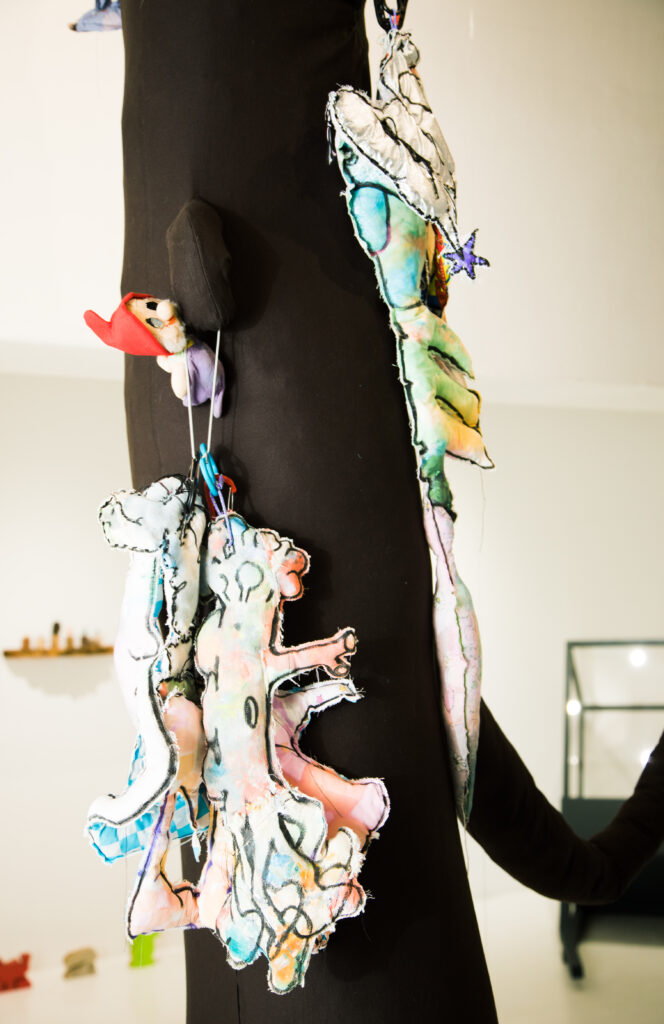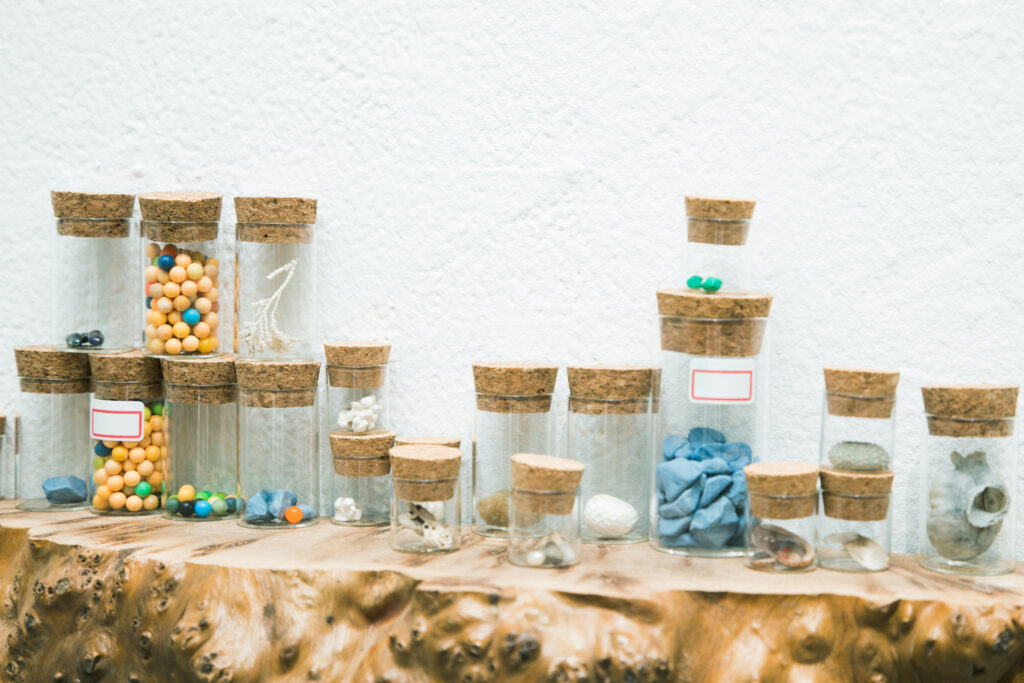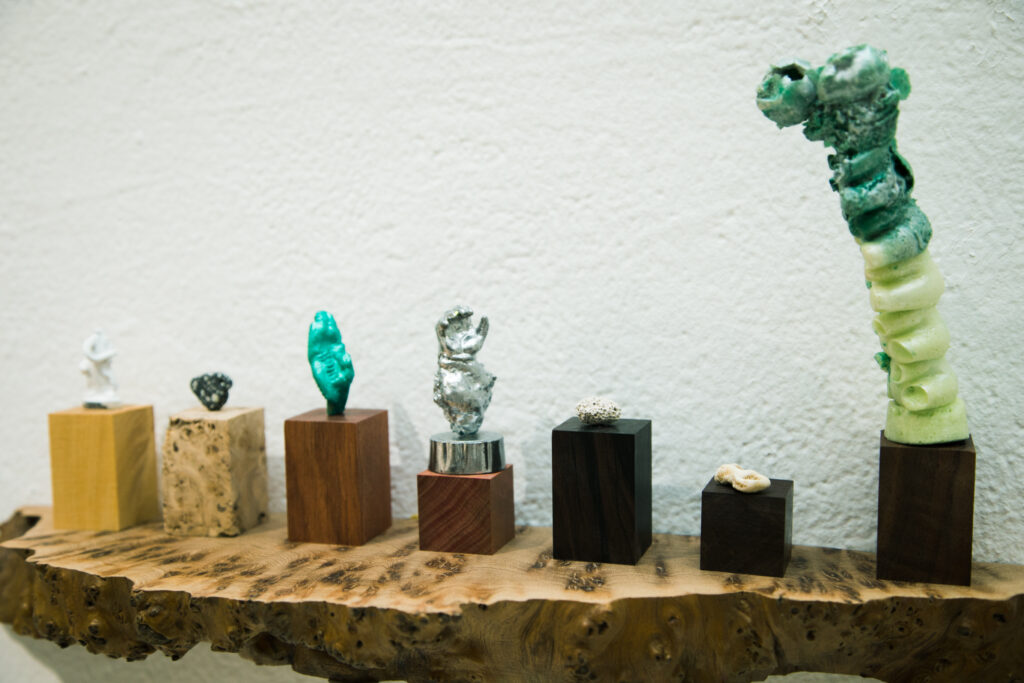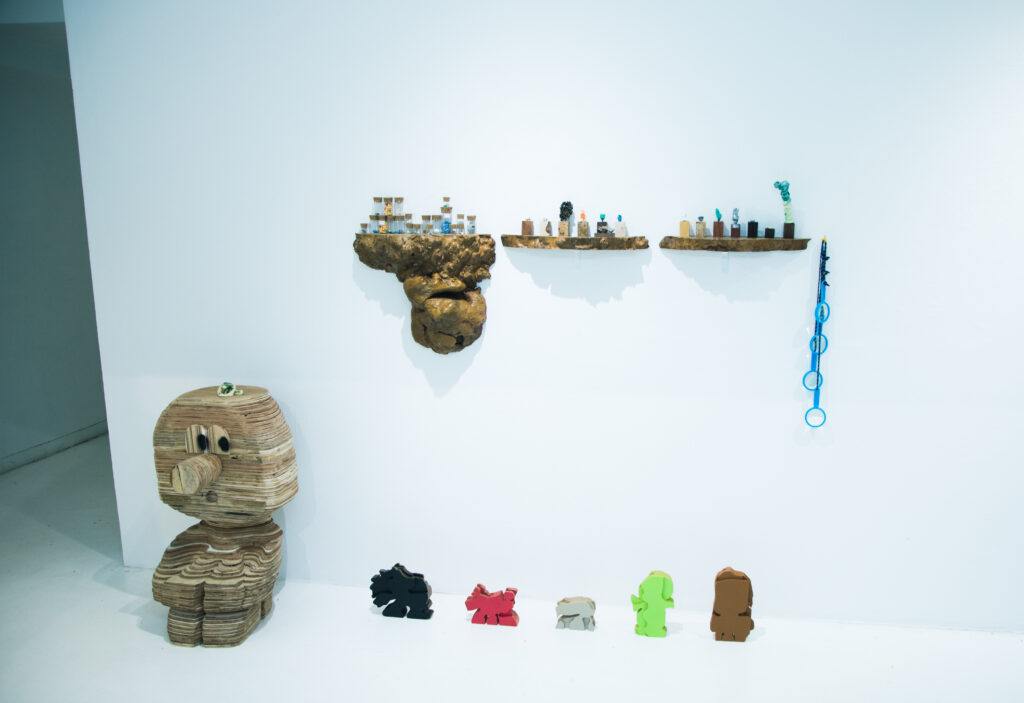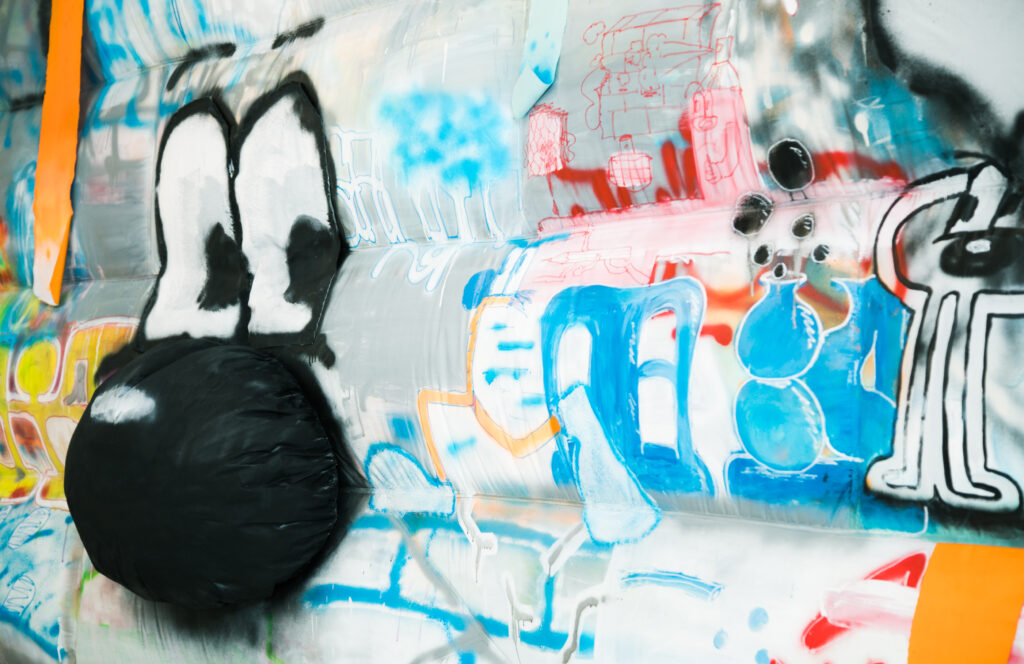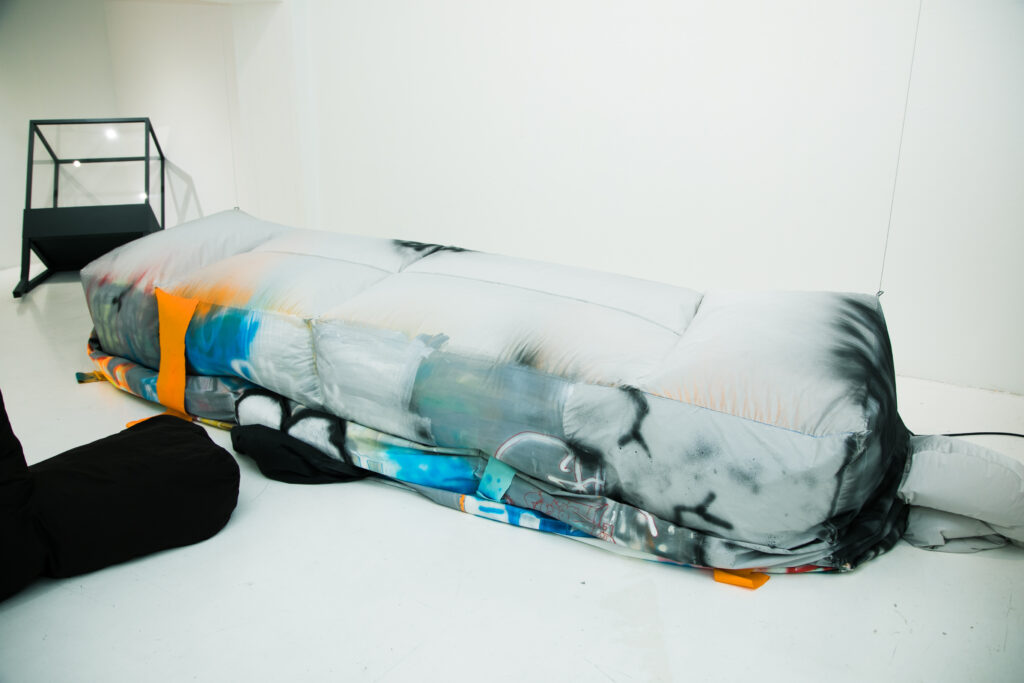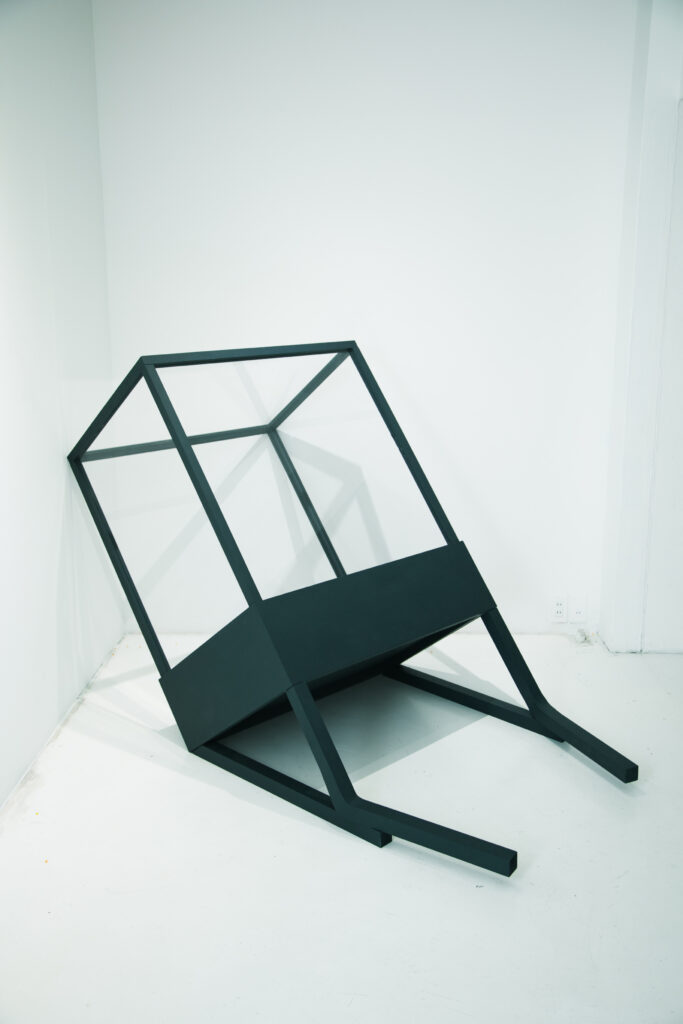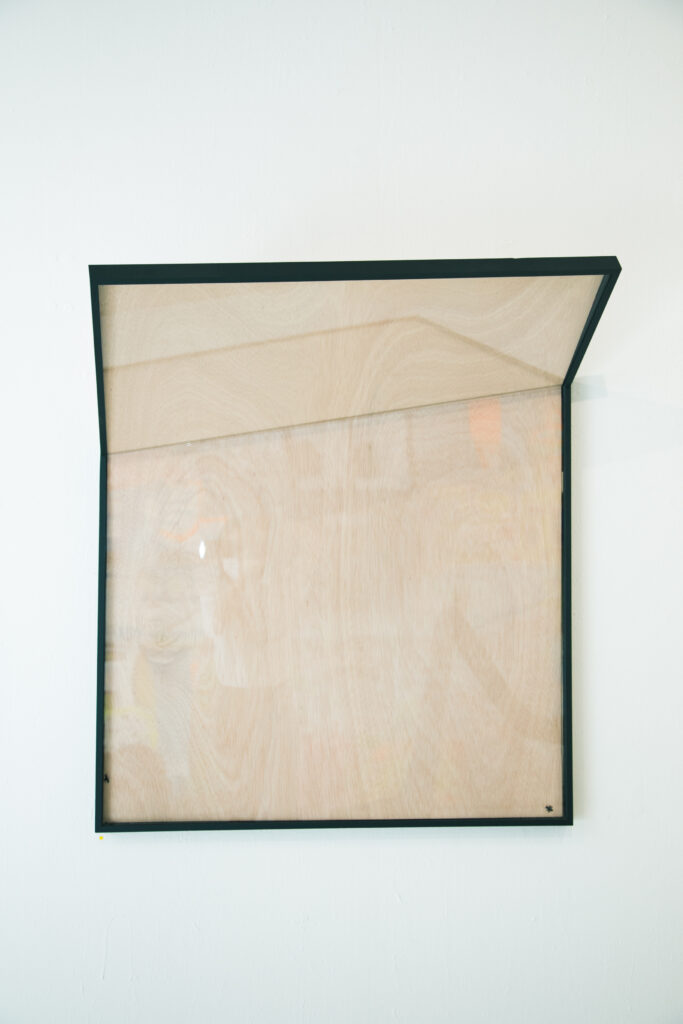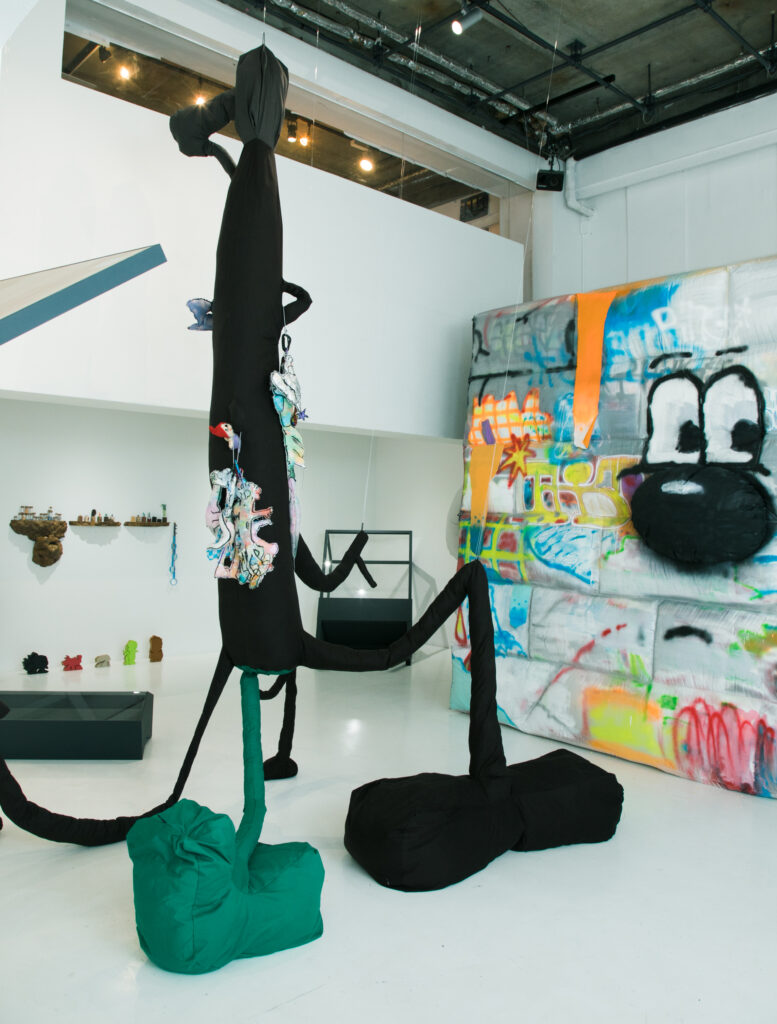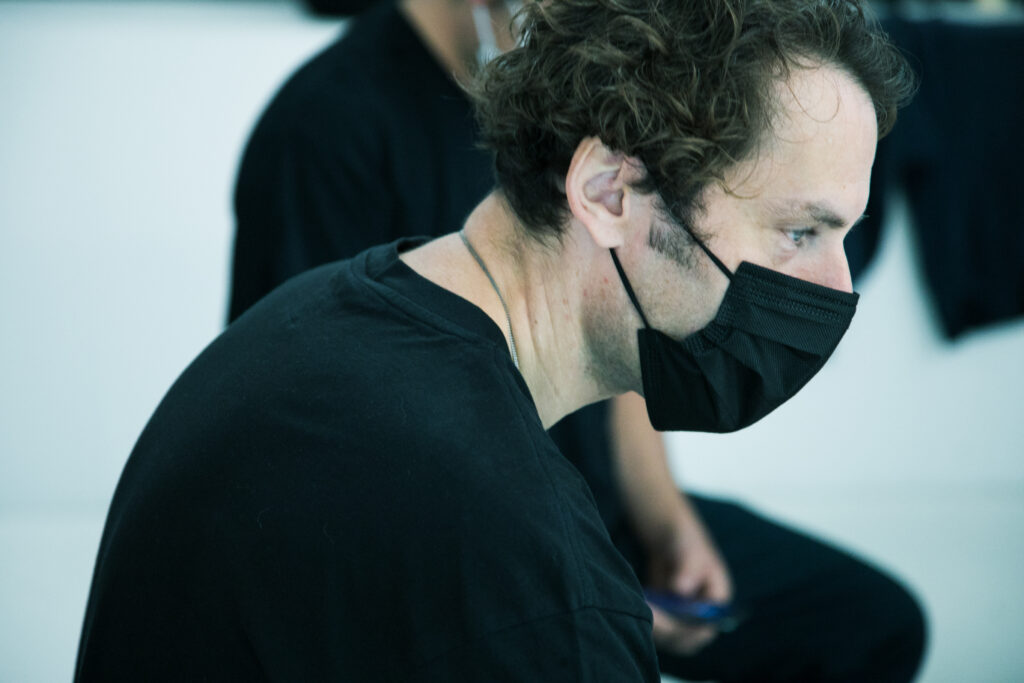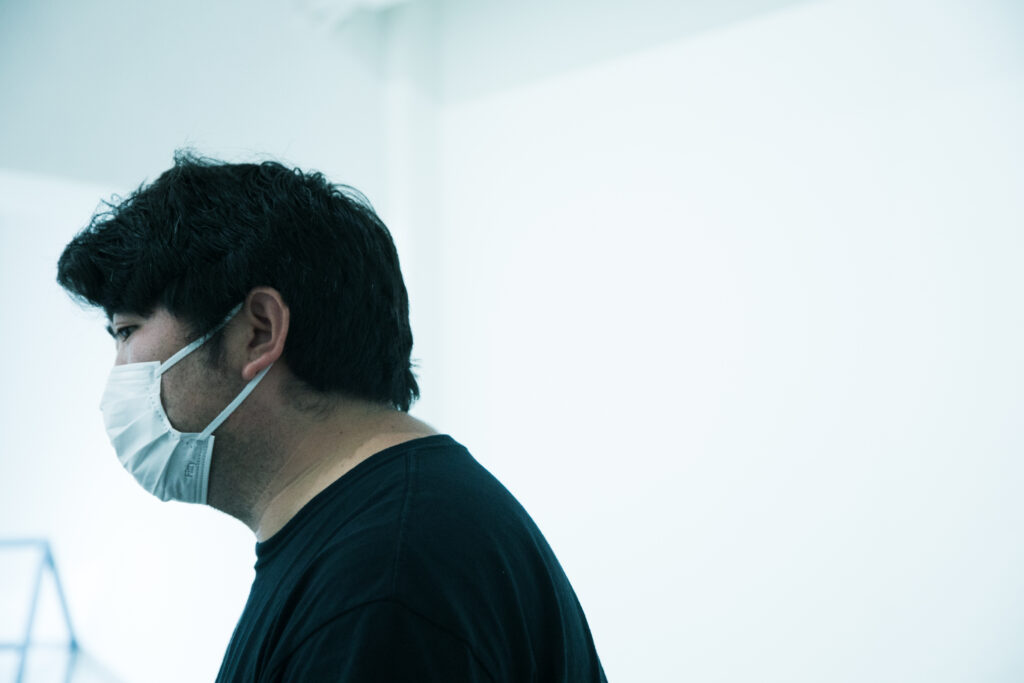The three artists, BIEN, DIEGO, and Russell MAURICE, who are all based in Tokyo and have graffiti in their background, have been working to embody their key concept “Comic Abstraction.” They held their first joint exhibition “AFTER APOX.”
The title of this exhibition “AFTER APOX.” is an abbreviation for “AFTER APOCALYPSE.” How will inanimate objects and plants behave in the world after humans disappear? In their works, they offer their own interpretation of the apocalypse and animism (the belief that everything in the natural world has a unique spirit) through contemporary visual languages.
The three artists, who tend to create two-dimensional and semi-three-dimensional works, solely worked on three-dimensional works in this exhibition. Taking advantage of the five-meter ceiling height of the gallery, they showed sculptures of various sizes, including the largest and smallest in the gallery’s history.
An artist and independent curator Kenta Ishige acted as a host, and BIEN, DIEGO, Russell MAURICE, and the gallery manager Noriyuki Abe joined him to have a round-table discussion about the background and context of the exhibition.
–First of all, can you talk about the theme of the exhibition?
Noriyuki Abe (Abe): In the beginning, I had to figure out a concept that would encompass all three artists’ works. When Russell spoke to me about his idea that he called, “AFTER APOX.”, I thought it was perfect, and that’s what we named the exhibition.
Russell: It’s an important part of my art, I guess. I feel that sometimes political art is not good because you’re forcing your political views on people. For me, the state of the earth is…. I dont think it’s even political anymore, it’s just a disaster. So I can’t not talk about it. Even if how I’m [expressing my views on the state of the environment] is sometimes abstruse or abstract, it’s present in my work. So I guess this time it just stepped to the front, you know what I mean?…with a big foot.
–I see. Russell, can you talk about some of your works in the exhibition?
Russell: [Referring to his work “Flight of the Caliginous Topiary with Plastic Bags in His Hair” placed in the center of the gallery space] I mean, it’s very literal. It’s a big tree and it’s about scorched nature basically. It’s just a very literal metaphor of [the state of] nature today. And the tree tops are dotted with white objects. Here, they signify plastic bags. In Africa they call them plastic flowers– there are so many littered plastic bags flying around in the wind and it’s a very common sight to see them stuck in trees. I almost wanted to call [this piece] “Plastic Flowers” but I thought it was too obvious. The actual objects themselves aren’t representing pollution. Just the idea…. For me, [this work] is obviously about [the environment]. I think that nature is an endless source of inspiration, and that’s it. haha. It’s chaos and perfection and destruction and life, death, everything, colour.
DIEGO: I thought it would be good to make use of the height of the ceiling and the characteristics of the gallery space. Also, I imagined that if the three of us were to put our works on display stands in the same way, it wouldn’t be very interesting because it would be very monotonous.
Russell: My first ideas or desires were to have table tops with a lot of small sculptures on it from everyone. When we met to discuss this plan, we got drunk and a bit messed up and uh, the plan changed considerably. Haha Taishi’s doing… so…[we ended up going big]. (Pointing to the table that holds small sculptural pieces titled “MACRO WUNDERKAMMER ON MEDULLARY RAYS”) For me, sculpture is about exploring form and shape so this was a kind of reaction to my first idea. For a while, while preparing for the show, I was talking to Nori about scanning these objects and printing them out bigger but it occured to me that I didn’t need to. It occured to me that it could be just as strong [to keep them small]–it’s the perfect contrast or antidote to the big [sculptures we have]–a small sculpture show within a sculpture show. For me this is a “mini-exhibition”. A sort of micro-world or a microcosm. The name comes from the Cabinet of Curiosities (a room or display that featured a collection of objects or artwork that were obtained during travel, often a testament to the adventurous spirit of the collector) — [the idea was that] these things are historical collections of interesting objects. In the past I’ve talked about alchemy (pointing to “MACRO REFRACTIVE INDEX ON MEDULLARY RAYS”) and the idea was to have ingredients for alchemy among sculptures. I wanted something that was mysterious or to make people think. Hopefully inspire people.
–DIEGO, your works focus on artifacts in the city rather than natural objects, which are different from Russell’s, right?
DIEGO: As a member of SIDE CORE, I usually utilize other people’s power and time, just like civil engineering work. So when I work on my own, I want to create works that can not only dominate the space in an instant but also disappear in an instant, with less power and effort. Also, I’ve always liked graffiti and street art, so I guess that’s why I chose the wall as my motif. When a wall is built, that opens up new possibilities. Say, you can draw something on it, but it can also divide something. Since I usually personify things in the city and incorporate them into my paintings, I thought it would be good to create something in that context. I wanted to create a work that triggers movement and spatial transformation, like when a wall rises up an alleyway is created behind it, or the alleyway disappears in an instant when the wall goes down.
–Having Seen your work in the exhibition “Machi he Deyo (Let’s Go Out to the City)” held at Watari-um Museum of Contemporary Art and this show, I was thinking that you were beginning to express the city, the wall, the support, and the environment itself. Is there any change in your consciousness in relation to it?
DIEGO: Having been inspired by the city and graffiti, I started with painting on canvas, from which I moved on to working on three-dimensional objects. In terms of graffiti, I personally think that the elements of “one’s point of view” and “action” are really important. And if you want to make a piece of art out of such elements, you have to share the experience. However, I can’t just say, “Let’s all go graffiti painting together,” so the likes of installation and the works I showed in this exhibition are necessary because viewers can re-experience my “point of view” and “actions” through appreciating them. I wanted people to understand my works by knowing what I like and feeling my point of view. That’s probably why I started to make works out of the environments itself.
–BIEN, as you mentioned in the very first part of interview, you were planning to create a work representing sleeping furniture in a humanless world, right?
BIEN: Even before this exhibition, I wanted to take something that was made for human use and put it to sleep in a state where it is useless. So, as DIEGO said, after thinking about what would go well with the gallery space, I decided to deal with the display stands, frames, and other things relating to it. As I was working on the story, I came up with a situation where they were sleeping because they no longer had a role to play after the people/users disappeared. In addition, after the people are gone, the art work itself has no value, and the things that were supposed to be on the display stand are gone, but I thought that even in such a situation, ants might still be alive. The ants are there to embody the situation where man-made objects are used in a different way by a different species than human.
Abe: When I was talking to the visitors this time, we were talking about the classic animation scenes where furniture dances. However, I think that most of the furniture in such animations is classical, but this time, the furniture looks modern and is like a fixture that could be found in a contemporary art museum. What we were talking about was how fresh it looks just due to that difference between them.
BIEN: Since I like this kind of animation, the shapes of works may be derived from animation expressions, such as the softly curved shapes instead of the shapes composed entirely of straight lines. But animation expressions are not a direct theme for this project.
What we felt after creating three-dimensional works
— My impression is that all of you have been mainly working on two-dimensional works. I’d like to ask you about your impressions of creating three-dimensional works. Was it different from the way you had worked on two-dimensional works?
Russell: Very much like drawing, I drew [the sculpture] and created a composition, you know what I mean? I think anything you create is a process. Even paintings. You start with a drawing and then the rest of the components of painting. Unless you have the whole thing planned out already, everything is a process of figuring out composition and colours and so….everything is a process. (Referring to his work) This was a sketch that was about this big. I drew it to scale. And then I measured it with a ruler approximately and then I sewed it. It was very slow…sewing. Also, because of time constraints, I just had to make it and hope for the best.
It does have an outline but it’s a solid fill. So maybe [this sculpture] is a painting, it’s still kind of 2D. So everything I make is 2D [in a way] I guess, haha.
–I think “lines” were also a very important element in BIEN’s works. This time, however, lines don’t appear in your three-dimensional works, can you say anything about that?
BIEN: Until a while ago, when I made two-dimensional works, I used to draw something on a single panel. But recently, I have been making works where I can reassemble the panel itself. Since I was originally interested in thinking about the structure of the painting itself, I started to change the shape of the support medium in that context. As a result of focusing only on the support itself this time, I think the main focus of the work was placed on creating a form using the display stand, just as I made panels.
–In your solo exhibition “DUSKDAWNDUST” at PARCEL , you presented drawings on panels that place emphasis on both the support medium and the content, then you focused solely on support medium for this exhibition, right?
BIEN: Yeah. When I make a piece of work, I’m interested not only in the act of drawing, but also in the medium of painting itself, so the artworks for that exhibition ended up being something like a puzzle. From there, I created this work to present a different way of looking at it, as a result of exploring how I can play with it.
Abe: I think BIEN’s signature style is embodied in works with deformed lines, but after seeing the work shown in this exhibition, I feel that viewers are now able to think of BIEN’s work in a different way. I was glad and thrilled that he brought a work that did not feature the lines he usually use. It looks so fresh. BIEN’s works usually have an original form of lines and then they are deformed, and I usually use words like “abstraction” to describe it, but we talked about how “deformation” is more appropriate. We’ve talked about the fact that this work also transforms the concept of existing display tools, and that’s what it has in common with his previous works.
BIEN: What I am doing with my drawings is not abstraction, but deformation. There is an original motif whose form collapses and becomes indistinct. To put it simply, it’s not an abstraction created by sputtering techniques with paints and brush, it’s more like playing with existing things as images. I hope that through this exhibition, people will realize that that’s what painting is all about for me.
–DIEGO, you said earlier that you wanted to create something unique to this place, but did you have a different approach to your previous three-dimensional works?
DIEGO: Whenever I make a large installation or a three-dimensional work, I don’t think of doing it all by myself. It’s not because I’m trying to make things easy, but because I always feel that things go better and ideas grow more when I work with someone else than when I work by myself. I think this is also connected to the concept of crew in graffiti culture. For example, when you go out to draw something with friends, you tend to get a better result. That does not necessarily means that I really like the concept of crew though. In this respect, it was so nice that I was introduced through GAS AS INTERFACE, the company that owns CALM & PUNK GALLERY, to Tsukada-san, who was in charge of sewing for this exhibition. Moreover, I think I was able to do something unique for this exhibition because of the personalities of this place.
Abe: As a member of GAS AS INTERFACE, I’m so glad to hear for the first time that you appreciate what we are always doing as a company, which is to connect artists with back stories of their creation and with enterprises.
DIEGO: Yeah. Personally, as long as the work is good, that’s all that matters. So the fact that this is my own work is not important. Rather, I’d be happier if Tsukada-san regards herself as co-creator. This time, I asked Tsukada-san to come and help me while I was installing artworks, because I tend to come up with more things to do on site. At first, I was planning to draw the nose part on the work, but I changed my mind, just as I had expected. I came to want to make this part be inflated. So I asked her to do it on site. This kind of encounter will not only help me in my future work, but I can also introduce this person to other people when they ask me for advice on their work. So I think it will open up many possibilities.
–After the exhibition, what did you feel about each other’s works?
Russell: Hmmm. It’s hard to say…
BIEN: Rather than mentioning each other’s work, I think the exhibition as a whole was interesting because of the various scales and perspectives that emerged. On the opening day, Russell suddenly started scattering BB bullets on the floor, and my ants were also placed among them, and there was DIEGO’s large and inflated artwork right next to them. From an ant’s point of view, Russell’s small works look big, but to a human, but from a human’s point of view, they can only be seen with a magnifying glass. It was interesting to see such a mixture of different scales in the exhibition space, where we could change our way of looking at things. You can imagine viewers other than humans through the exhibition.
DIEGO: I think the relationship between the three of us is also interesting. First of all, Russell is about three generations older than me, Bien is a bit younger than me, and I’m in the middle.
Russell: Don’t say that (laughs).
DIEGO: Well, seriously, I think Russell has had a big influence on the Tokyo street art scene. When I met him, he was still a mysterious foreigner, but he soon became active in Tokyo. Also, since he’s been around the graffiti scene since the 1980s, it’s been interesting to learn from him about it. I’ve been witnessing BIEN’s works since he was a student, and he’s been very active as well. So I’ve always been inspired by him.
Russell: This whole process has been good because it pushed me to do things that I personally wouldn’t do. And it made me think differently in my creative approach. I’m happy that this object came out of this (points to his sculpture). How did I think the exhibition went? I think it’s a good contrast of three [very] different styles that somehow gel together.
–Please tell us about your plans for your future exhibition.
Russell: I have a solo show coming up at PARCEL. I think there’s going to be a lot of paintings in this show. But I’ve got some ideas. I’m still wrestling with trying to make transparent paintings. We tried it at the OIL Bijutsu Techo show but I wasn’t 100% happy with the materials. I’m going to attempt to make some more transparent or semi-transparent paintings. I’ve got some ideas I’m pushing: what painting is or what it can be. I’m a little scared that they will be too weird or too crazy for people to be able to digest. I need to find the line between accessible and weird which often I go too far over accessible into weird. haha.
Abe: It would be nice if we could have a sequel exhibition in a year or two.
DIEGO: We will be worried about a lot of things (laughs).
Abe: Well, maybe I’m just saying (laughs).
BIEN
Born in Tokyo in 1993, BIEN is an artist who predominantly uses drawing as a form of expression. Influenced by street culture, animation and model figures, he creates abstract paintings and installations that appropriate the various styles of expression of these cultures, attempting to deconstruct and reconstruct symbolic meanings.
Instagram:@bien_jap
DIEGO
DIEGO started working on what is called street art in his teens. With his nerdy point of view, he became familiar with graffiti culture and street art, and continued to express himself from a unique perspective in the city, and somehow became a “slowly becoming known” street artist. The awkward and cute characters that appear in his works are “characters of unknown creator” that he found from retro signs that he found when pedalling his bicycle around the city, or from old printed materials that he found in used bookstores. Inspired by Toy Graffiti, which is becoming popular among a new generation mainly in Europe, he developed the his own mysterious letters through his own perspective. In recent years, he has been working as a member of SIDE CORE, organizing exhibitions and presenting his works, and also directing his own mural program for artists from around the world.
Instagram:@diego7a14
RUSSELL MAURICE
Born England 1975, currently lives and works in Chigasaki, Japan. Maurice’s involvement in Graffiti Culture from the early age of 8 (1983) was an important influence. Maurice’s expression is interwoven with elements of animation, comics and animism, portraying these through semi abstract paintings, Cel painting, two and three-dimensional collage, sculpture and photography (and these often mixed together). He has been exhibiting his works and organizing exhibitions internationally and is considered a chief catalyst in the new phase of the Comic Abstraction movement.
Instagram:@gasius
CALM & PUNK GALLERY
CALM & PUNK GALLERY was established in 2006 in Nishiazabu, Tokyo. The gallery exhibits a broad roster of artists, both native and international, working within a diverse range of mediums. Merging high and low culture, the gallery’s curatorial practice aims to represent versatile modes of expression. In addition to classical mediums like painting, drawing, and sculpture, CALM & PUNK GALLERY has a strong affinity towards new media that embody innovation in the arts including graphic design, product design, and various other digital media. The gallery also publishes GASBOOK under its operating company GAS AS I/F. Garnering popular and critical acclaim starting in the 90’s and 00’s, the art books are known for their sharp and novel features on artists and leaders of youth culture.
Instagram:@calmandpunkgallery
Photography Mayumi Hosokura
Transalation Shinichiro Sato

